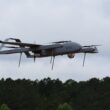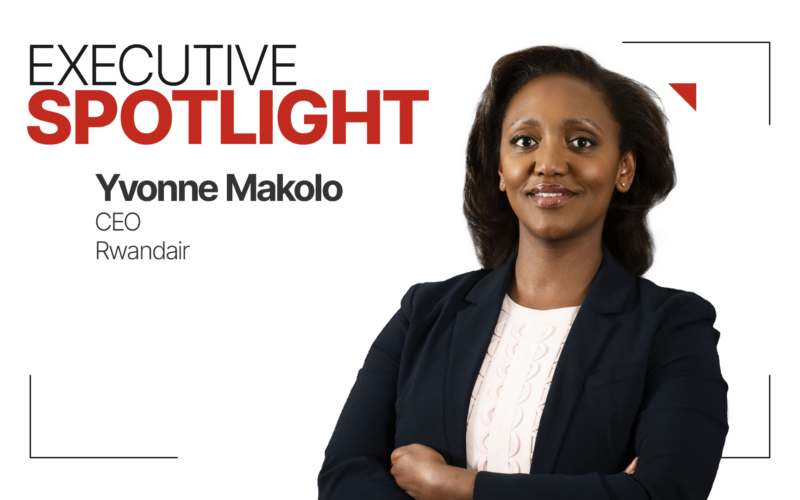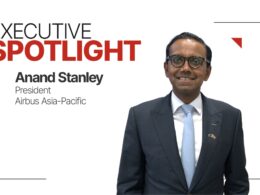Landlocked in the heart of Africa, Rwanda has left behind a not-so-distant troubled past to emerge as one of the continent’s hottest tourist destinations, as well as one of its key air hubs. The national airline, Rwandair, has been instrumental in this.
The journey of the fully state-owned airline, from operating a single wet-leased turboprop aircraft to becoming one of Africa’s most successful carriers and a close partner of Qatar Airways, has taken more than two decades and a thorough rebranding in 2009.
However, the airline’s CEO, Yvonne Makolo, believes that RwandAir is still far from realizing its full potential.
AeroTime caught up with Makolo to learn more about the growing airline, its current international expansion, and its strategy for the years to come.
Makolo came to RwandAir from the IT industry, after more than a decade at Rwanda’s national telecommunications operator, where she rose to become Chief Marketing Officer. She was appointed Deputy CEO of RwandAir in 2017 and then, a year later, she became the airline’s CEO.
“What I like most about this industry is that it’s never boring. There’s always something happening. It’s exciting work,” Makolo revealed. “For me, just being part of this amazing airline that is growing and is supporting the growth of this country is very exciting.”
An ambitious airline
Makolo was clear on the airline’s long-term strategic goals:
“Our focus is to connect Rwanda to the rest of the African continent and to the rest of the world, and also to connect African countries with each other,” she explained. “We believe this continent has a lot of untapped potential and, given that the road and rail networks are pretty much nonexistent across the continent, air connectivity plays a key role.”
“We have seen the impact of the airline on the country of Rwanda,” she added.
In talking about the tourism boom that Rwanda is currently experiencing, raising the subject of the civil war and genocide three decades earlier is inevitable. In this case, though, it’s to highlight how this small African nation has moved on from that turbulent period in its history.
“We see the impact that the airline has had on the country, and where Rwanda is now, 30 years after the genocide against the Tutsi, from many perspectives: the economy, tourism, sports…” Makolo said. “The airline has been instrumental in growing those areas and we believe the same can be replicated in other countries too. We believe that aviation is key when it comes to developing our continent.”
But what came first? Is RwandAir’s growth a byproduct of the increasing popularity of its home country as a tourist destination? Or is it the other way around, with the carrier’s capacity expansion itself driving this increase in the number of visitors to Rwanda?
“It’s a bit of both,” she said. “The Rwandan government is very ambitious and very deliberate in terms of what needs to happen for the country. So, from a tourism perspective, tourism has become the main foreign exchange earner for Rwanda. Before it was coffee and tea and all that, but now it is tourism.”
“There is traditional tourism coming to see the gorillas and our beautiful country. There is also conference tourism,” Makolo explained. “Kigali now is number two, after Cape Town, in terms of the number of conferences it hosts within the African continent.”
“Rwanda is also positioning itself as a sports tourism destination. We have built lots of infrastructure – the arena, the new stadium, which has been refurbished, the golf course. There are lots of sporting events taking place in Rwanda as well”, Makolo said, citing the final of the Basketball Africa League (BAL) as an example.
But the intrinsic attractiveness of a country is often not enough to make the tourism and air transportation industry flourish. Makolo made this point clear.
“What makes Rwanda attractive for all this is the accessibility of the country,” she said. “Having direct routes through RwandAir or the other airlines that come into the country does make it a lot better to come here.
“The government has also made it easier to get visas. Anyone from any country can get a visa on arrival here in Rwanda, which is very different from a lot of other African countries that have incredibly complicated visa regimes. Plus, it’s an attractive country, it is safe. It’s clean. So, the product is really good, and I like to believe that RwandAir has played a key part in opening up the country and making it more accessible so that people can experience its beauty.”
Makolo thinks this is a model that other African countries could emulate and RwandAir can help make this happen.
Building Africa’s newest air hub
Makolo also noted that the majority of traffic used to be point-to-point, but the percentage of transiting passengers has now grown.
“Now we have both point-to-point and transfers as well as a small number of fifth freedom passengers.” [The Fifth Freedom of the Air is the right an airline has to fly passengers between two points outside of its own home country – Ed. Note]
Makolo also touched upon plans to turn Kigali’s new international airport, currently being built with Qatari support, into an alternative hub for the region, starting in 2027-28.
“Our transit traffic has grown as Kigali grows more and more into a hub,” she said.” I would say point-to-point is about 45%, while 50% is transit and 5% is fifth freedom flights.”
Asked about the general direction of these traffic flows, Makolo further elaborated on RwandAir’s network strategy, explaining that the airline currently services 24 routes.
In early 2024, RwandAir suspended its service to Mumbai (BOM), India. However, it has been adding capacity on other long-haul routes, such as those linking Kigali (KGL) to London Heathrow (LHR) and Paris Charles de Gaulle (CDG), which are operated with Airbus A330 wide-body aircraft.
“When it comes to traffic flows, it’s a bit of everything,” she explained. “What we’re seeing is growth in terms of north-south traffic, especially with our London route. We’ve been growing the London route from three flights per week to daily flights. So, by the beginning of May 2024, we’ll be operating daily flights to London-Heathrow.
“Our recently launched Paris route is also performing very well, especially connecting to Central African countries, and to a certain extent to East African countries. So, we’re happy with that as well.”
“And then, of course, we have flights to Dubai (DXB) and Doha (DOH),” she added. “At Doha we connect to the Qatar Airways network. So, it’s a little bit of everything. But our aim, as I mentioned, is really connecting Africa to the rest of the world through Kigali.”
The Qatari connection
The partnership with Qatar is particularly important to RwandAir, and the African carrier has been increasing frequencies to the Gulf hub.
“We started with three flights a week and now we have six flights a week, and we hope to continue doing that,” Makolo said. “We are very happy with that route, [and] with the fact that we are able to connect to their hub and they are able to connect to ours. So, their passengers can also access some of the routes that they don’t fly to directly.
The relationship with Qatar is more far-reaching than a mere codeshare agreement between airlines, though. The Gulf emirate is a key investor in both the Rwandan airline and the country’s airport infrastructure.
“Rwanda and Qatar, the two countries, have a very strong relationship and that has built into commercial relationships in the aviation sector,” Makolo explained. “So, for the last few years, we’ve been discussing and working towards having Qatar – previously it was Qatar Airways, now it’s the Qatar Investment Authority, but Qatar Airways is the implementing body – take a 49% stake in the airline, with the Rwandan government keeping the remaining 51%. Qatar was also to become the majority shareholder of Kigali airport, with 60%.”
She referred to the brand-new airport that is currently being built near Kigali with Qatari backing and which is going to become Rwandair’s new home once completed.
“So, for the airport, the project is ongoing, construction is ongoing. We are at 80% plus of the first phase, which is the horizontal works, and they’ll move towards the vertical works soon – later this year. For the airline it’s a bit more complicated, because we are already in operation, but we are finalizing the deal on that end.”
“In the meantime, we’re working very closely together,” she added. “From a commercial perspective, out of 74 routes we codeshare with partners, 67 are with Qatar Airways.”
Mokolo also noted that the airline’s commercial partnership with Qatar Airways extends to their respective loyalty programs.
“Passengers being able to earn and burn miles on each other’s loyalty programs, such as supporting us from a human resources perspective. So, while we’re waiting for the deals to be finalized, we’re working very closely together, and we value that relationship.”
She added: “We believe it will be very good in helping to take the airline to the next level and having a very strong airline to grow the aviation market here in Africa. So that’s at high level, pretty much what this relationship is about.”
Connecting Africa
RwandAir also operates a number of fifth freedom flights between African countries.
“We have Lusaka-Johannesburg, Harare-Cape Town, Brazzaville-Douala, Douala-Cotonou, Bangui-Douala, Accra-Abuja. So, we have a few fifth freedom flights,” Makolo noted. “A lot of our routes started off as fifth freedom flights, and then as they grew, we now service them as stand-alone. So, we were hoping even for these ones, as we grow the routes, we’ll be able to attack them and have more point-to-point.”
Makolo doesn’t shy away from expressing the airline’s ambition to become a pan-African operator. This is something that a number of operators have tried in the past, with Rwandair’s competitor Ethiopian Airlines perhaps coming closest to realizing this concept.
Makolo also identified the many challenges airlines encounter when operating across Africa, although she also expressed her belief that these could be worked on and overcome.
“The biggest barrier is definitely the cost of operation within the African continent,” she said. “Everything is a lot more expensive, which makes achieving profitability a big challenge.
“Fuel is much more expensive than what you find in Europe or the Middle East. Navigation fees, parking fees, airport taxes – everything is at a premium when flying within the African continent.”
“The second issue is Open Skies,” Makolo said. “For some countries, it’s a big challenge to either enter, start flying into another country, or build additional capacity on certain routes, adding additional frequencies or accessing additional points within the same country.”
Makolo said the potential setting-up of an Open Skies framework has been discussed many times, and it’s been advocated through different quarters, and more recently, under the umbrella of the Single African Air Transport Market (SAATM), a project the African Union to create a single unified air transport market in Africa.
“We are hopeful and keep advocating for it,” she added. “This will make it much easier for African airlines to really take off and connect the continent.”
Makolo said infrastructure is another big barrier, particularly “a lack of investment” which also presents “a big challenge from a safety perspective”.
“And, of course, the issue of visas, which is a big, big problem for many African countries. That really makes it complicated for people coming into the country, as opposed to just opening up and allowing people to move freely between the different countries,” she continued.
The potential is there, Makolo said, as the population of Africa is 1.4 billion, but the percentage of traffic is minimal, totaling around 2%.
She added: “We just need to remove some of these stumbling blocks to allow the aviation sector to really take off.”
Geography favors the Kigali hub, and the completion of the Rwandan capital’s new airport, currently being built at a greenfield location about 35-40 minutes from where the current airport is, should also help boost traffic.
“We were looking at about six million passengers in the first phase, which will be almost three to four times what we have in the current airport,” Makolo said. “Other phases will be added on as traffic picks up.”
She added that the country’s central location “definitely helps access different points much more easily”.
“Like several other airlines with a high percentage of transit passengers, Rwandair has created its own stopover product,” Makolo said. “Kigali is a relatively small city, so it’s easy to get around very quickly. If you have a one-day stopover, you can see a lot of pretty much the whole city in the one day that you have.
“We do have a stopover product which we recently launched, which we are pushing, which involves hotel accommodation, visiting different sites within the city. People have the option of going to play golf – there’s a huge golf course here as well – and visit the different markets to see the local products.”
“It’s an interesting product. It’s a very good entry point into seeing Rwanda and then deciding whether you really want to come and visit,” she added. “We believe we have the potential to grow this and in turn help grow tourism within the country.”
Building a world-class airline
RwandAir operates a two-class cabin (business and economy) across its entire fleet.
“We have a very good product, starting with the A330s, these fairly new aircraft we have, which do our long-haul flights,” Makolo said. “Originally it was a three-class product, with business, premium economy and economy, but we’re no longer selling premium economy.”
This move was primarily to ensure product consistency across the airline’s network.
“We’re selling it as economy because it became a challenge,” Makolo explained. “When you’re flying from, let’s say, London to Nairobi, going from Premium Economy on the A330 to then transfer onto another aircraft that doesn’t have Premium Economy becomes a bit of a challenge. In order not to disappoint the passengers, we thought it would be best to phase it out. So, we just sell economy and business class at the moment.”
Makolo talked proudly about the airline’s offering, particularly its premium product.
“We have a very good business class with 1-2-1 configuration and lie-flat beds,” she said. “We have a very strong onboard product. We have a very well-trained crew. In 2022 we won the Skytrax award for the Best Airline Staff in Africa.”
“There’s this stereotype that on African airlines the quality is not good, that the product is not good. We want to go beyond that and show that African airlines can deliver a strong product at an affordable price because Africans deserve good things as well.”
“We have business class on our whole fleet, including the regional jets, the Q400s and CRJs,” Makolo said. “So, the rest of the fleet is a two-class fleet as well, not just the wide-body aircraft. We’re very proud of what we offer, and we intend to grow that even more.”
As of April 2024, Rwandair is operating a fleet of 14 aircraft, an eclectic mix of Airbus A330s, Boeing B737NGs as well as Bombardier/Mitsubishi CRJ-900 regional jets and De Havilland Canada Q400 Dash 8 turboprops.
“We are working on growing the airline,” Makolo said. “Our plan is to double our fleet within the next five years, and we are on track to do that. We intend to continue growing, especially within the African continent, opening additional routes within Africa. So, the next few years we will be focusing on opening African routes.”
While the total number of aircraft in the fleet is likely to soon increase, the number of aircraft types operated by the airline is to be cut from the current five to just three. By doing so, Rwandair will have one aircraft type for each market segment in which it operates: regional, short and medium haul and long haul.
Makolo continued: “We do intend to lease rather than purchase aircraft and we are also looking at rationalizing the fleet, to at least have three types: one type for the regional, one for the medium-haul, and then the long-haul. We’ll keep the 737s and the A330s. We’re still looking for the regional, to see what exactly fits our future plans. That’s yet to be decided, but we will be rationalizing our fleet as well.”
“The 737s are currently our biggest fleet right now,” she continued. “Half of our aircraft are 737s and they’re really the ones that allow us to access quite a number of points within the African continent. So, I expect the 737s to remain our main aircraft type.”
The cargo opportunity
Another area earmarked for further growth is cargo. RwandAir received a 737 freighter one year ago and is preparing to continue investing in this market segment.
“We recognize the importance of cargo, and we want to grow that revenue stream,” Makolo said. “It is going to be a big focus area for us, possibly getting additional freighters and fully leveraging the belly capacity of our existing aircraft.”
The airline carries fresh produce to Europe and Dubai, bringing different products, such as general goods, car spare parts and pharmaceutical products back to Rwanda.
“The export sector in Rwanda is growing so we do intend to support that. With the implementation of the African continental free trade area, we do intend to leverage that to really connect the African countries and move people and goods between the different countries.”
“So, there’s a lot of potential once that this is fully implemented,” she said. “We do intend to leverage that.”
Makolo also shared some details of other projects RwandAir is currently undertaking to enable and support this projected growth.
“We want to grow our local capacity in terms of pilots and engineers, so as not to be overly reliant on expatriate pilots,” she explained.
She continued: “We recently onboarded the first batch of cadet pilots and that’s going well. We look forward to continuing growing because we do believe that, in order to be a strong airline and to be a strong aviation hub here in Kigali, we need the skilled resources, the local skill, to really leverage that to grow the company.”
To this end, in October 2023, Rwandair received a US$23.6 million loan from the African Development Bank to set up the Centre of Excellence for Aviation (CEAS), an aviation training school that is expected to open in 2025 and will have a capacity for 500 students per year.
“We are also building our maintenance capacity,” Makolo added. “We used to outsource our maintenance to different MROs [Maintenance, Repair and Overhaul]. A year ago, we set up our Approved Maintenance Organization (AMO), where we do up to eight A-checks here for all our fleet except the A330.”
“We are working towards also handling our own A330s and eventually growing into a full MRO,” she revealed. “We are doing it progressively, but that’s the future plan – to also become a fully-fledged MRO.”










